Unpacking and publishing the Phaistos Disk since 1993
HOME PREVIOUS NEXT SITEMAP
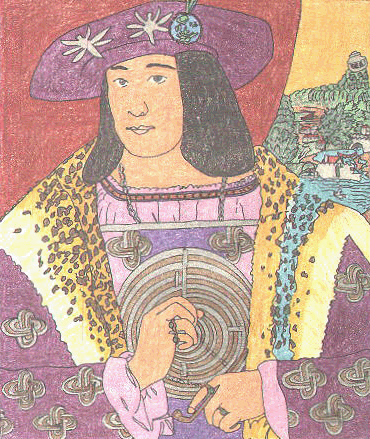
Emanationism and the Curtain are two of the three ideas portrayed in the mysterious portrait of the Anonymous 16th Century Gentleman, 1510 CE, (left, Illus. 1, after Bartolommeo Veneto). In the portrait, as in the philosophy, the Curtain separates the celestial realm of Mind from the material universe of Idea. The Creator is expressed in terms of The Boundless Light shining through from the other side of the Curtain and illuminating this side. Also seen is the analogy of overflow, as the pond in the Otherworld (on the other side of the curtain) overflows its banks and pours down the Gentleman's left shoulder in his world. The overflow symbolizes the unity and reliance of both the temporal world and the parallel dimension of the timeless world for the creation of our reality.
On the other side of the curtain are the palaces (Hekhaloth) of the celestial realms known in Judaic Kabalism as the beautiful realms of Or En Soph (The Boundless Light). In these realms are held the preexistent images--the Forms taken by living matter. The Italian Emanationist seen in the portrait was most likely familiar with both Kabalism and Hermeticism, as were many enlightened Italians of that period, thanks to Cosimo de Medici's interest in these ideologies. Cosimo's interest in the metaphysical made it fashionable to be spiritual and "alternative" during the Italian Renaissance.
The third subject of this portrait is Form, expressly that of Archetypal Human, the form that living matter takes in the production of an individual. Archetypal Human also was known in antiquity as Anthropos, Adam Kadman and Heavenly Man. Archetypal Human is human form out of space and time.
'S/he is all humanity, man as the 'species'--Homo Sapiens, but at the same time possessing the characteristics, peculiarities and individual earmarks of all separate men. This is you and I and Julius Caesar and the conspirators who killed him and the newsboy I pass every day--all beings, all slaves, all saints, all sinners--all taken together, fused into one indivisible being of a (hu)man, like a great living tree in which are bark, wood, and dry twigs; green leaves, flowers and fruits. Is it possible to conceive of and understand such a being by our reason?"
This unusual concept of reincarnation is challenging to comprehend because it is a long way from the common notion of reincarnation, in which an identical first soul is reborn into the body of a human or animal, according to karma. In the unusual concept, there is no physical rebirth of the individual, who exists instead In Ascension, a place as real and eventful to that Soul as our reality is to us. Also challenging to grasp is the accompanying concept of an individual's "past-life memories" as being the experiences of another individual within the collective soul and not really one's own personal memories, in the strictest sense.
This involves Neshima Consciousness, wherein the individual souls gain awareness of the existence of each other. Experiencing the "past-life memories" that belong to one's counterpart in another space-time dimension heralds the dawning of the level of consciousness called Neshima. In full Neshima consciousness, according to Rabbis, who cannot utter the word "reincarnation," the counterparts are aware of each other and they communicate. This communication is facilitated by souls in the collective who are incorporeal and nonspatial. These "messenger souls" may have been known by many names: Hermes Mercurius Trismegistus in Alchemy, Nous or Mind in ancient Hellenistic theosophy, the Dove of the Holy Spirit in Christianity, the Divine Infant in Taoism, the Guardian Angel in Kabalism, the Divine Messenger in Gnosticism, Poimandres the Good Shepherd in Hermeticism and Thoth the Divine Mind in the ancient Egyptian religion.
Jesse, representing the Source Soul from whom all the others emanate, sleeps in P13 (see above) with open eyes, symbolizing Neshima consciousness.
"And there shall come forth a rod out of the stem of Jesse, and a Branch shall grow out of his roots." Jesse's Tree of Life is comprised of David in P10, Mary in P7, and Jesus in P4. Jesus is merging with the descending Dove of the Holy Spirit--the Heavenly Partner--in P1. Along the Central Pillar of the World Soul, the individuals are connected at the backs of their heads by the white trunk of the tree, representing the pure and powerful stream of consciousness that flows along their collective spinal column and that corresponds to the world axis of the macrocosm. The human body is the microcosm, the creation in miniature of the cosmic body, the macrocosm.
Jesse's counterparts on the outer pillars of the tree are aligned with Portals 4, 7, 10 and 13 of the Central Pillar. The artist achieved this alignment by raising P4, P7, P10 and P13 and by lowering P1. David, Mary, and Jesus assist in the alignment by raising the connecting paths. According to this art, Jesse and his counterparts devoted their lives to spiritual matters and the World Soul and now have acquired gnosis through self-knowledge and self-awareness. They are Christian Kabalists who are working together with the help of the Heavenly Partners (Spirit Guides, Guardian Angels, Doves of the Holy Spirit) to further their awareness of the Higher Self. The individual souls, all standing in golden rectangles, pass along some of their esoteric knowledge as they give instruction on the geometry of the upright golden rectangle of the World Soul.
The first descendant in P3, top left, stands fully the length of the rectangle. Beneath him, Solomon (Salomon) in P6, with an emblem of his temple on his head, indicates with his right hand that the rectangle is to be measured from the tip of his temple to the tip of his big toe of his left foot. Beneath him, Sibilla in P9, seconds these instructions, indicating that the length is to be measured from the outside double line. Beneath her, Ezekial in P12, instructs on measuring the width, which is to be measured from the inside double line. The people on the right give similar instruction.
One such individual soul of a World Soul like the Jesse Tree is the Anonymous 16th Century Gentleman (above left), whose collective soul may include Lord Pacal. Perhaps he is a member of a lightbody network of enlightened souls or Archetypal Human like the members of the Jesse Tree.
The feather emblem on the Gentleman's hat is the sacred bird on the Sarcophagus of Lord Pacal and P1 on the World Soul. The ruffled neckline of his shirt is the serpent-curtain of the Sarcophagus. The Gentleman's chin and throat are P4, which is the small semicircle on the Sarcophagus just above the Curtain. The Gentleman is wearing a chain-link necklace over his shirt and under his tunic. The necklace, descending in a V pattern to a point in the center of the round maze, symbolizes "vital chains," (2) the planetary chains that hold the spheres (planets) on course. On the sarcophagus, the vital chains appear as small circles in groups of three that descend in a V pattern to the inside of the serpent-curtain, converging at the Limit-Cross (V4-H2). Pacal's World Soul-cosmos is suspended in space by these chains that hold it on its appointed course. On the portrait of the Gentleman, the Limit of Limit-Cross (H2) is the horizontal edge of his tunic, which joins P5 and P6, his shoulders. On the sarcophagus, H2 joins P5 and P6, portals (spheres) resembling shoulders and suggesting Archetypal Human (above far right, Illus. 5).
Where Lord Pacal extended the next portion of the World Soul, the Gentleman compressed it. The Gentleman's hands are oddly positioned in the shape of a figure 8 like Pacal's. His right fist is in the center of a combined P7-Pl0, which is the center of the vortex on his tunic. In his left hand he holds a pipe, D27. The crook of the pipe is P13. He wears fur like jaguar, the fur of the Maya and of the burial shroud of Lord Pacal. It is impossible that the Anonymous Gentleman visited Palenque and viewed the Sarcophagus. Palenque was abandoned in the 8th century CE, rediscovered in the 19th century and the Sarcophagus unearthed in 1952. The solution to this reincarnation mystery is found within Emanationism, within the concepts of Ideal Form, the World Soul and the Higher Self. The vortex on the Gentleman's tunic symbolizes the Vast Vortex, the Cup or Crater of Hermeticism, the Mixing Bowl that the Creator stirs round and round creating a whirlpool and a funnel. The Vortex, at another level of representation, is the Portal in the Curtain, the negative space called Daath in Kabalism which is somewhat like a black hole theorized in astronomy. Daath, defined as "Knowledge" (or Gnosis) in Kabalism and situated in hidden Portal 4 on the World Soul (see above with Jesse Tree), is said to be hidden because it is supposed to be "negative space.' (3)
Daath, symbolized by the 4 green rings worn by the 16th Century Gentleman, is located on the Central Pillar of Consciousness, existing both at the back of the head, in subjective-nonordinary reality, and outside in the physical world, in objective-ordinary reality (As Within, So Without). In ordinary reality, the Shamanic portal is a cave or a tunnel near water, as seen behind the Gentleman on the portrait. The subjective-nonordinary portal is described in shamanism as "the fontanelle, or so-called 'soft spot' location in the top rear of the head where the temporal and occipital bones meet." It is "an important entrance and exit point for power," (4) and is seen in operation on the Jesse Tree as the merger of Jesus with the Dove.
Several partial convergences or incomplete Daath Portals on the outer pillars are seen on the World Soul. This indicates that the Abstract Lightmatrix, which is a single, unified conceptual construct, is only a representative section of a space-time continuum. By placing several World Souls side by side, we can see a continuum in progress. Each portal is a combination of a vortex, a funnel and a negative space, or vertex. Subjective-nonordinary portals, such as the ones we are studying and the ones existing metaphysically, correspond to objective-ordinary geophysical portals, which are entrances and exits outside of us and in the landscape, like the rabbit hole in Alice in Wonderland. Both kinds of portals facilitate mental projection into the nonspatial realms. In various civilizations can be seen the attempt to create more powerful geophysical portals in support of the metaphysical portals of the inner cosmos. The geophysical portals at Palenque, Mexico, for example, are in the temple-pyramids. (far left) At the top of each pyramid is a temple containing an interior with an antechamber and three rear sanctums. The center chamber, called the "pib na," is a miniature house (middle, compared with a Minoan sanctum, below it). The pib na is the physical portal and the equivalent of the metaphysical portal, which the Mayas called "wacah chan xaman waxac na" - The World Tree House of the North Created by God I. Wacah also means "6" and chan means "sky." 6 sky is portrayed as P6 on the World Soul and on the Sarcophagus. The triangle formed by P4, P5 and P6, all emanated or created by P1, is the World Tree House of the North, the portal in the ethereal realm of the Limit-Cross and the Curtain.
The Maya House of the North is the Cosmic Building or World-Building of the ancient Egyptians and the "House" of the Sumerians. Inside the pib na is the geophysical portal into the supernatural realm of emanation called Otherworld by the Maya. Otherworld is called the Dreamtime by the Australian aborigines and is called Lowerworld by the Chinese.
The Portal to Otherworld could be opened when a Mayan achieved an altered state of Shamanic consciousness. To achieve this state of consciousness, many of the Central and South American Indians drink an hallucinogen, but the Mayas used another method. They inflicted physical pain upon themselves in order to enter the trance-like state of consciousness. The men used an obsidian knife to cut the penis, and both men and women ran a rope of thorns through the tip of the tongue. When the portal(s) opened, the Energy-Intelligences from Otherworld entered and exited the body through the fontanelle, giving the shaman a privileged position vis-a-vis the universe.
In the cosmology of the Mayas (above), the temple-pyramid is at the center of the material world, ruled by the great shamanic power animal, the crocodile. At the top of the pyramid is the pib na of wacah chan xaman waxac na, the Portal through which one may enter Otherworld and view the realities there. Below the power animal is the Lowerworld, where the ball game of the afterlife is played.
"I thought of the soul as resembling a castle, formed of a single diamond or a very transparent crystal, containing many rooms, just as in heaven there are many rooms." This profound understanding of the structure of creation and of the Curtain and the Portal was widespread for three millennia, most especially in some notable instances, particularly ancient Egypt and Sumer, ancient Crete, the Golden Age of Greece and the Italian Renaissance. In the last 1500 years these concepts became occulted, all but lost to us now. The ancient, universal ideas were replaced by the inferior and uninspiring concepts of Darwinism, the theory of human evolution from apes. Evolution is only part of the story and a minor, mechanical part, at that.
Where form or archetype is concerned, time and space are all one, and it does not matter that the American Mound Builders were in American, the Mayas were in Central and South America and the Egyptians were in Egypt. The symbol for Cosmos is the same in all cases and this is because of the hidden spiritual realities. Nor does it matter that Australian X-ray art and Easter Island heads are continents apart and centuries apart. They still may express the same enduring form or archetype, the same hidden pattern.
The Easter Island heads were created about 400 CE. The Australian aborigines say the prehistoric cave drawing was created during the dreamtime, the mythological past that exists as a parallel dimension in the form of the abstract universe. The cave drawing shows that the massive rock and the fragile flower are different but complementary aspects of the same form. All life, animate and inanimate, is comprised of a nonphysical component or it could not physically exist, and the nonphysical always accompanies the physical. Therefore, a source exists to which we may elect to return after death and even prior to it!
Footnotes: 1. P.D. Ouspensky, Tertium Organum; 2. Plato, Timaeas; 3. Pamela Eakins, Tarot of the Spirit; 4. Michael Harner, The Way of the Shaman
Illustrations: All Illustrations are by the author. 1. After Bartolommeo Veneto; 2. After Randall and Vicki Baer; 3. After 12th century CE manuscript illustration, color added; 4. After Ted Andrews, color added; 5. After P. S. Berg, color added; 6. After Pamela Eakins; 7. After National Geographic artist; 8. After T. A. Busink, color added
 Two or more humans may be different but complementary aspects of the same archetypal form or World Soul - the collective soul sometimes known as Source Soul, Oversoul and Higher Self. The World Soul as collective soul continues to reincarnate, producing individuals patterned upon itself. The Light-Body Network (left, Illus. 2) is one illustration of this network of individuals within the collective. The souls or sparks of the same Source Soul or World Soul exist individually, each in its own space-time dimension, but they partake in the larger reality of a Higher Self outside space-time.
Two or more humans may be different but complementary aspects of the same archetypal form or World Soul - the collective soul sometimes known as Source Soul, Oversoul and Higher Self. The World Soul as collective soul continues to reincarnate, producing individuals patterned upon itself. The Light-Body Network (left, Illus. 2) is one illustration of this network of individuals within the collective. The souls or sparks of the same Source Soul or World Soul exist individually, each in its own space-time dimension, but they partake in the larger reality of a Higher Self outside space-time.
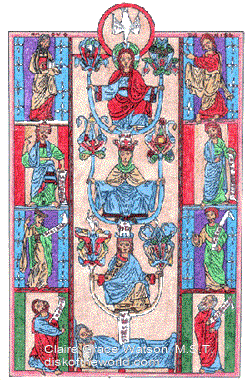
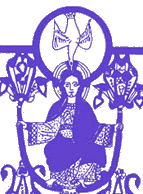
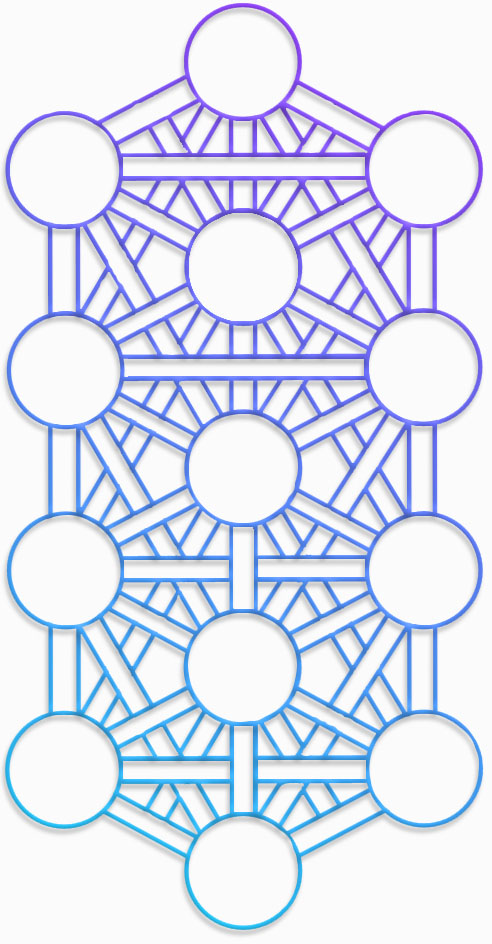 Neshima consciousness is both the cause and effect of a lifted Curtain, affording a glimpse into the eternal realities. The World Soul containing the individual souls, some of whom may not gain awareness of each other through Neshima Consciousness, is portrayed by the Jesse Tree (above left, Illus. 3), originally created by an inspired Emanationist.
Neshima consciousness is both the cause and effect of a lifted Curtain, affording a glimpse into the eternal realities. The World Soul containing the individual souls, some of whom may not gain awareness of each other through Neshima Consciousness, is portrayed by the Jesse Tree (above left, Illus. 3), originally created by an inspired Emanationist.
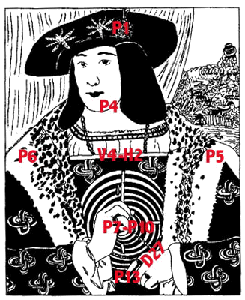
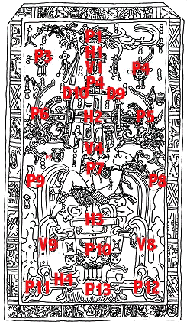
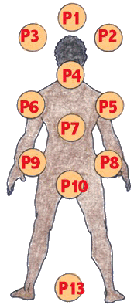
Portals to Other Realities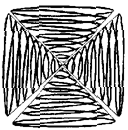 Portal 4, the portal in the Curtain of space-time and energy-matter, is represented by all five of the portals on the Central Pillar of Consciousness, each one a negative space in which are converged 4 planes of emanation or existence. In geometry, Daath is symbolized as a single point within a circle.
Portal 4, the portal in the Curtain of space-time and energy-matter, is represented by all five of the portals on the Central Pillar of Consciousness, each one a negative space in which are converged 4 planes of emanation or existence. In geometry, Daath is symbolized as a single point within a circle. 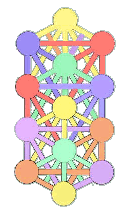
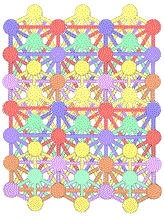
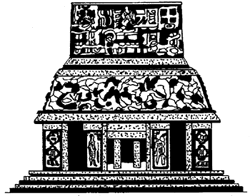
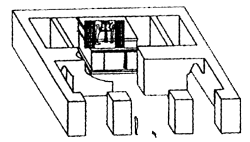
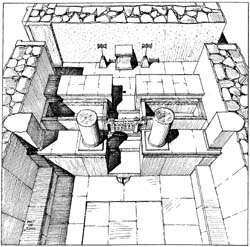
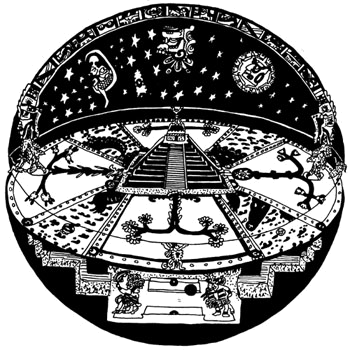
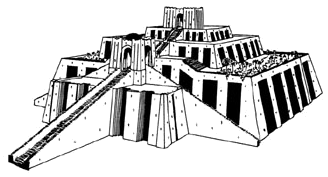 Like the Mayan pyramids, the ziggurats of ancient Mesopotamia, such as the Ziggurat of Ur, 2100 BCE (left), and Dur Sharukin, were topped by a temple-portal and built as a residence for the god during his/her descent to earthly sojourn. The god would descend to the top of the temple, marked by an 'E,' meaning House, and rest upon the bed provided.
Like the Mayan pyramids, the ziggurats of ancient Mesopotamia, such as the Ziggurat of Ur, 2100 BCE (left), and Dur Sharukin, were topped by a temple-portal and built as a residence for the god during his/her descent to earthly sojourn. The god would descend to the top of the temple, marked by an 'E,' meaning House, and rest upon the bed provided.
![]() In ancient Crete, "E" referred to the pyramid of Cheops and also meant "House." (My interpretation of a symbol on the Phaistos Disk.) In the Microcosm the "god' is the Heavenly Partner, "E" marks the fontanelle or Crown chakra, and the "House" is the human brain.
In ancient Crete, "E" referred to the pyramid of Cheops and also meant "House." (My interpretation of a symbol on the Phaistos Disk.) In the Microcosm the "god' is the Heavenly Partner, "E" marks the fontanelle or Crown chakra, and the "House" is the human brain.
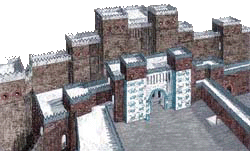 1500 years after the ziggurats, at the time of Nebuchadnezzer II (605-562 BCE), the "House" architecture was fully developed in the Ishtar Gate, Babylon, dedicated to Ishtar, goddess of love and war, whose House this is. (left, Illus. 8)
1500 years after the ziggurats, at the time of Nebuchadnezzer II (605-562 BCE), the "House" architecture was fully developed in the Ishtar Gate, Babylon, dedicated to Ishtar, goddess of love and war, whose House this is. (left, Illus. 8)

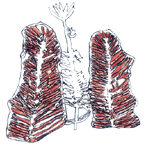
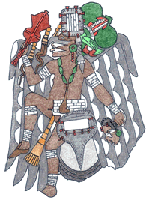 Finally, in this series of images displaying the three concepts of House, Figure 8 symbolism and form or archetype, is presented for interpretation this Etowah Mound Builder Indian, Etowah, Georgia, shell engraving (500 BCE). The North American Mound Builders are believed to be ancestors of the Mayas. This Falcon-Man (right) dances the Cosmos. The Cosmos was symbolized by the ancient Egyptians as the god-man Horus (Cosmos), whose symbol was the falcon on the perch. The Horus-falcon, standing upright on the horizontal bar or perch, is the ancient Egyptian symbol of Limit-Cross or Horos-Stauros or, ultimately, Cosmos (Horus).
Finally, in this series of images displaying the three concepts of House, Figure 8 symbolism and form or archetype, is presented for interpretation this Etowah Mound Builder Indian, Etowah, Georgia, shell engraving (500 BCE). The North American Mound Builders are believed to be ancestors of the Mayas. This Falcon-Man (right) dances the Cosmos. The Cosmos was symbolized by the ancient Egyptians as the god-man Horus (Cosmos), whose symbol was the falcon on the perch. The Horus-falcon, standing upright on the horizontal bar or perch, is the ancient Egyptian symbol of Limit-Cross or Horos-Stauros or, ultimately, Cosmos (Horus).